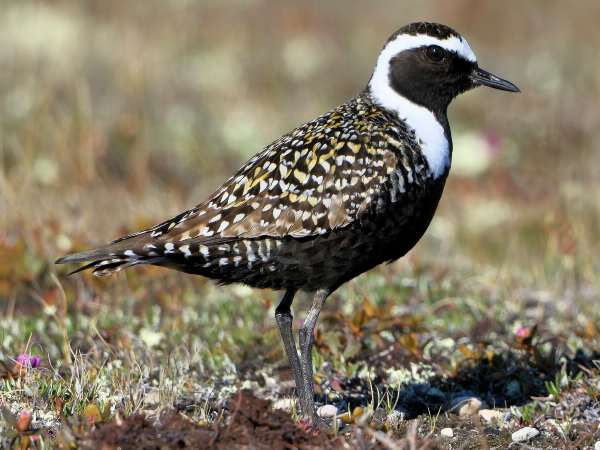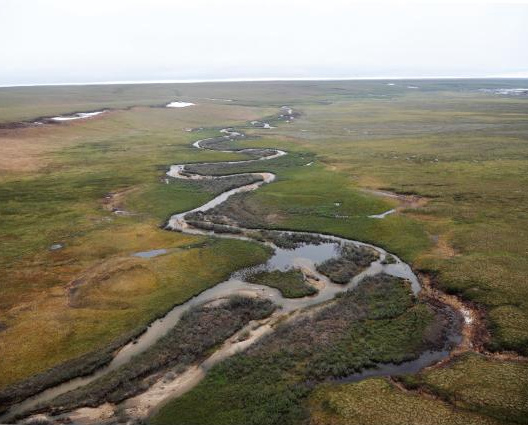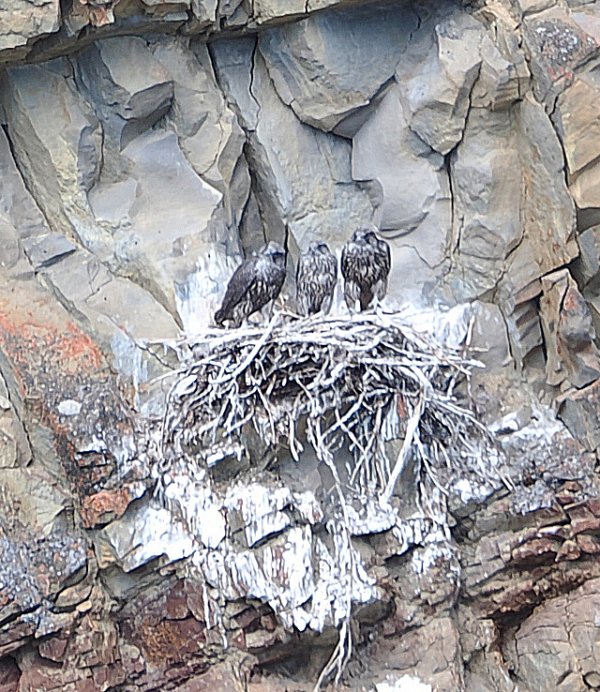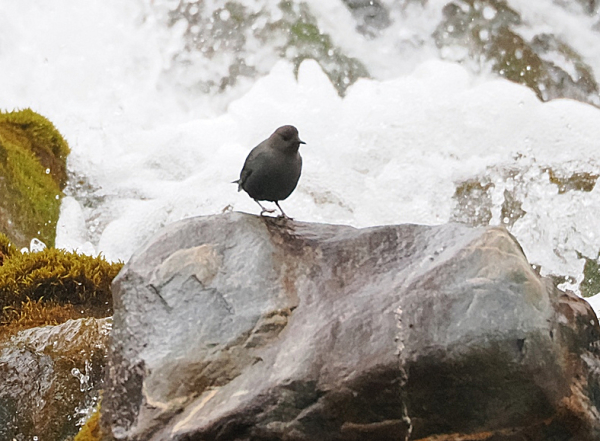
American Golden Plovers were among Lois’s favorite birds encountered on their nesting territories in the Arctic National Wildlife Refuge.

A winding river flows across a tundra wilderness in the Arctic National Wildlife Refuge.

This brood of 3 soon to fledge Peregrine Falcons was observed along the edge of the Canning River in the Arctic National Wildlife Refuge (photo by Catherine Zimmer).

American Dippers were a favorite bird of Catherine’s during the rafting trip. Catherine described dippers as a unique songbird that swims underwater (photo by Catherine Zimmer).
|
It’s a place every birder would hope to experience one day, one of the most remote, bird rich refuges in our National Wildlife Refuge System – the Arctic National Wildlife Refuge. Often referred to as “America’s Serengeti,” the Arctic Refuge is a broad open land of tundra-covered Coastal Plain carved by occasional rivers that rush north from the mountains of the Brooks Range, also part of the vast refuge. Such exciting birds as nesting American Golden Plovers, Arctic Terns, Peregrine Falcons, American Dippers, Eastern Yellow Wagtails, Smith’s Longspurs, Snow Buntings, and many more nest here, then migrate south, southeast, and southwest to winter in 6 continents after the nesting season.
America’s largest and northernmost wildlife refuge is truly wild and virtually untouched by human hands, with no roads, established trails, buildings, or facilities of any kind, and it includes the largest designated Wilderness Area within the National Wildlife Refuge System. During late spring, millions of birds including migratory waterfowl, shorebirds, and songbirds arrive to nest across the tundra and associated wetlands south of the Arctic Ocean. They share the refuge with large mammals such as huge herds of barren ground caribou, and wolves, muskox, polar bears, grizzly bears, moose, and other impressive wildlife.
Last summer my friend and associate Lois Norrgard, joined a group of adventurers who embarked on a raft trip along the Canning River, which flows north along the west side of the Arctic Refuge. Lois shared: ““This truly was a life changing experience, as far as you can see it is untouched wilderness. It was such a treat to see the vibrant, thriving birdlife that I heard so much about over the years. Songbirds to raptors the life of this place was awe inspiring.”
The native plants are equally diverse and abundant. Lois also wrote that during her late June visit “the tundra was full of an amazing variety of flowers, and it was so surprising to see that some of the plants and flowers were so very small, about the size of my thumbnail – and seemingly so delicate, yet they had to be super tenacious and hardy to live in this incredibly difficult environment.”
One of Lois’s co-adventurers kept a running bird list of the species sighted by all the adventurers collectively while they indulged in the grandeur of the Arctic Refuge. Catherine Zimmer provided the following list of birds encountered along the Canning River and associated tundra and wetlands. On some days, the best birds showed when the group stopped to camp along the way.
Arctic Refuge Bird List
Arctic Tern
Red-throated Loon
Red-necked Grebe
Short-billed Gull
Glaucous Gull
Herring Gull
Black-legged Kittiwake
Peregrine Falcon
Merlin
Rough-legged Hawk
Golden Eagle
Bald Eagle
Osprey
Cackling Goose
Canada Goose
Canvasback
Bufflehead
Blue-winged Teal
Red-breasted Merganser
American Golden Plover
Semipalmated Plover
Least Sandpiper
Wandering Tattler
Cliff Swallow
Bank Swallow
Canada Jay
Common Raven
American Dipper
Swainson’s Thrush
American Robin
Eastern Yellow Wagtail
Horned Lark
White-crowned Sparrow
Lapland Longspur
Smith’s Longspur
Snow Bunting
Arctic Refuge News
Personally, at the top of my conservation issues is the wise use of public lands, especially national wildlife refuges and national parks. And at the very top of these interests is the continued preservation of the Arctic National Wildlife Refuge in northeast Alaska. Today we continue to celebrate this region as America’s Serengeti, for the varied and abundant wildlife found there, including the giant herds of caribou and millions of nesting birds that migrate to the coastal plain to nest each spring.
This remote refuge that protects a wild land that runs from the mountains to the coast is a slice of North America’s coastal plain that provides an essential summer calving area for caribou. And the region is a spiritual place for native people who live in northeast Alaska and northwest Canada – people whose ancestors have protected this location for millennia. They have long understood that without this area, the caribou population that they rely on for subsistence food and other materials would deteriorate, along with their cultural integrity.
However, some politicians have worked to turn this sacred land protected as a national wildlife refuge into an expansive oil field, destroying the natural integrity of the Arctic Refuge. Intense development without concern for the refuge’s importance to birds that migrate south to winter in southern Canada and the Lower 48 States – and points beyond, including 6 continents – South America, Asia, Australia, Europe, Antarctica, and North America!
Throughout much of my friendship with Lois, who works for the Alaska Wilderness League, we have worked together to promote the need to continue to protect the status of the Arctic Refuge as a premier national wildlife refuge. And for decades, an ever-changing group of politicians have wanted to extend the oil and gas development centered in Prudhoe Bay into the Arctic National Wildlife Refuge.
Recently, during an oil and gas lease sale mandated during the first Trump administration, it was announced that No oil company or other interest offered any lease bids on this extremely important area for birds, other wildlife, and the Indigenous Peoples of the region! Not one company.
It was a huge No answer to the politicians who mandated this lease sale, with the lack of interest by any oil interests blatantly showing that the Arctic National Wildlife Refuge is far too valuable to carve up into an oil field with all its accompanying infrastructure. That’s a big victory for the people of the United States and the world. For while this grand public land is the property of all citizens of America, it is so important on a global scale that it is truly a worldwide victory.
This didn’t happen by luck, many important conservation partners worked to inform politicians, oil companies, banks, insurance companies, and all Americans that this land is our land, and it’s preserved as a national wildlife refuge and wilderness area for millions of important reasons – for each bird, mammal, plant, and person that relies on it directly or indirectly – as well as every American and the people of the world.
The efforts of some uninformed and uncaring politicians will probably not end, but their interests in turning our treasured Arctic Refuge into a huge oil field is just not an option. In response to the failed January 6th lease sale, the National Wildlife Refuge Association stated: “The Arctic Refuge is a place where wildlife and people come first, not drilling.” I live in North Dakota, which has 63 national wildlife refuges – more than any other state – and as a former US Senator from North Dakota once told me, “The last place we should want to drill for oil is the Arctic National Wildlife Refuge, not the first!”
You can read more about this subject, so important to birders and all Americans, which was published by the Alaska Wilderness League at Another Arctic Lease Sale Fails | Alaska Wilderness League along with a statement available at the National Wildlife Refuge Association’s website: Oil Companies Reject Arctic National Wildlife Refuge Lease Sale— A Victory for Wildlife Conservation, Indigenous Rights & the Planet — The National Wildlife Refuge Association
Article by Paul Konrad